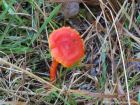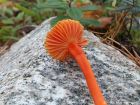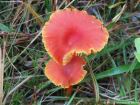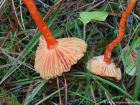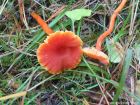Cap small, convex to flat and sometimes shallowly funnel-shaped with age, often finely scaly or fibrillose rather than smooth. It ranges in colour from reddish-orange to orange-red, fading paler towards the margin, which may become crenate with maturity. The surface is dry or slightly tacky but never slimy, and the flesh is thin, firm, and yellowish to orangish. Gills distinctly decurrent, rather thick and waxy, spaced moderately to widely, and pale yellow to yellow, sometimes deepening in colour with age. Stem slender, cylindrical, and dry, occasionally silkily fibrillose, coloured orange to reddish-orange and usually paler towards the base. It lacks a ring and is solid or slightly hollow in mature specimens. Spore print white.
Microscopic Features: Spores ellipsoidal or ovoid to pear-shaped, measuring 7–9 × 4.5–5.5 µm, and inamyloid.
Hygrocybe cantharellus on the First Nature web site.
Hygrocybe cantharellus on the MushroomExpert.Com web site.
Many mushrooms are poisonous, and some can be lethally toxic. Distinguishing between edible and poisonous mushrooms can be very challenging. Therefore, we strongly advise against consuming wild mushrooms. This website does not contain any information about the edibility or toxicity of mushrooms.
Although efforts have been made to ensure accuracy on this website, the information may contain errors and omissions. Therefore, all content provided is for educational and informational purposes only and should not be relied upon or used as a basis for consuming any plants or mushrooms.
External links are provided for reference only. We do not endorse or take responsibility for the content, advice, or products found on these sites or in any advertisements shown on this website.
